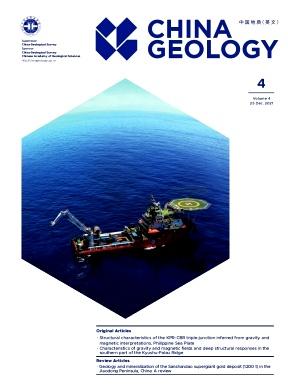Geochemistry and petrogenesis of Mesoproterozoic mafic granulite and amphibolite dykes from Saltora, Bankura district, Chhotanagpur Gneissic Complex, eastern India: Implications for their emplacement in within-plate setting
IF 4.7
3区 地球科学
Q1 GEOSCIENCES, MULTIDISCIPLINARY
引用次数: 0
Abstract
Distinguishing high-grade mafic-ultramafic rocks originally crystallized from within-plate basaltic magmatism is challenging and crucial because the chemical composition of the igneous rocks has been modified during high-grade metamorphism, causing misidentification of the characters of the parental magma. Proterozoic metamorphosed mafic dykes occur throughout the Chhotanagpur Gneissic Complex (CGC) of eastern Indian shield. The E-W trending mafic dykes from the Saltora area in the southeastern CGC underwent metamorphism in two episodes: M1 (650 MPa; 770°C) and M2 (300 MPa; 744°C). The metamafics are enriched in LILE, depleted in HFSE, and display strong fractionation of LREE, nearly flat HREE patterns in a chondrite-normalized REE diagram, and show tholeiitic differentiation trend. Their geochemical affinity is towards rift-related, continental within-plate basalts. About 7%–10% melting of the carbonated spinel-peridotite sub-continental lithospheric mantle (SCLM) produced the parental mafic magma. The pre-existing SCLM was metasomatized by slab-derived fluid during the previous subduction. The upwelling of the asthenosphere in a post-collisional tectonic setting caused E-W trending fractures, lithospheric thinning, and gravitational collapse. These dykes were emplaced during crustal extension around 1070 Ma. The remarkable geochemical similarity between the mafic dykes of Saltora and Dhanbad, the ca. 1096 Ma Mahoba (Bundelkhand craton), and the ca. 1070 Ma Alcurra mafic dykes in Australia supports a genetic link.
印度东部Chhotanagpur片麻岩杂岩区Saltora中元古代基性麻粒岩和角闪岩岩脉的地球化学和岩石成因及其在板内侵位的意义
区分最初结晶的高品位镁铁质-超镁铁质岩石与板块内玄武岩岩浆活动是具有挑战性和关键的,因为在高品位变质作用期间,火成岩的化学成分发生了改变,导致母岩浆特征的错误识别。元古代变质基性岩脉分布于东印度盾的Chhotanagpur片麻岩杂岩(CGC)中。鄂尔多斯盆地东南部Saltora地区东西向基性岩脉经历了2期变质作用:M1期(650 MPa);770°C)和M2 (300 MPa;744°C)。变质岩中LILE富集,HFSE贫,LREE分馏作用强,球粒陨石归一化稀土图显示近平型,并呈拉斑分异趋势。它们的地球化学亲缘关系是与裂谷有关的大陆板内玄武岩。约7%-10%的碳酸尖晶石-橄榄岩次大陆岩石圈地幔(SCLM)熔融产生母基性岩浆。先前存在的SCLM在之前的俯冲过程中被板块衍生流体交代。碰撞后构造环境下软流圈的上涌导致东西向断裂、岩石圈变薄和重力坍缩。这些岩脉形成于1070 Ma左右的地壳伸展时期。澳大利亚约1096 Ma Mahoba (Bundelkhand克拉通)和约1070 Ma Alcurra基性岩脉之间的地球化学相似性支持了一种遗传联系。
本文章由计算机程序翻译,如有差异,请以英文原文为准。
求助全文
约1分钟内获得全文
求助全文

 求助内容:
求助内容: 应助结果提醒方式:
应助结果提醒方式:


